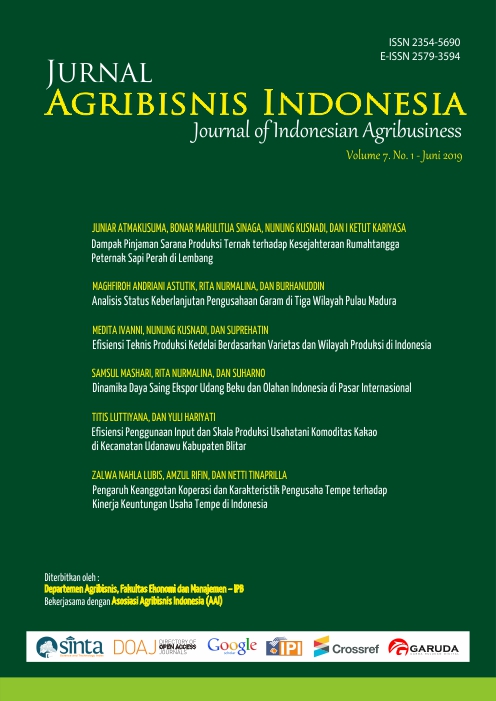DINAMIKA DAYA SAING EKSPOR UDANG BEKU DAN OLAHAN INDONESIA DI PASAR INTERNASIONAL
Main Article Content
Abstract
Downloads
Article Details
Jurnal Agribisnis Indonesia (JAI) is an Open Access Journal. The authors who publish the manuscript in this journal agree to the following terms:
Creative Commons License
JAI is licensed under a Creative Commons Attribution 4.0 International License. This permits anyone to copy, redistribute, remix, transmit, and adapt the work provided the original work and source are appropriately cited.
This means:
(1) Under the CC-BY license, authors retain ownership of the copyright for their article, but authors grant others permission to use the content of publications in Jurnal Agribisnis Indonesia in whole or in part provided that the original work is properly cited. Users (redistributors) of JAI are required to cite the original source, including the author's name, JAI as the initial source of publication, year of publication, volume number, issue, and Digital Object Identifier (DOI); (2) Authors grant JAI the right of first publication. Although authors remain the copyright owner.
References
Ashari U, Sahara, Hartoyo S. 2016. Daya Saing Udang Segar dan Udang Beku Indonesia di Negara Tujuan Ekspor Utama. Jurnal Manajemen dan Agribisnis. 13(1): 1-13.
Ciffolilli A, Muscio A. 2018. Industry 4.0: National and Regional Comparative Advantages in Key Enabling Technologies. European Planning Studies, 26(12): 2323-2343.
Edwards L, Schoer V. 2002. The Structure and Competitiveness of South African Trade. The South Africa Journal of Economic. 70(6): 1-37.
Güneş S, Tan M. 2017. Static and Dynamic Revealed Comparative Advantage: A Comparative Analysis of Turkey and Russia. İktisadi Yenilik Dergisi Journal. 4(3): 22-38.
Hasni. 2018. Daya Saing Ekspor Produk Makanan Olahan Indonesia ke Timur Tengah.Buletin Ilmiah Litbang Perdagangan. 12(2): 235-265.
Jittapong K, Dhanananphorn M. 2014. Thailand's shrimp output seen recovering from disease woes in 2015. https://www.reuters.com/article/thailand-shrimp-exports-idUSL3N0U22KB20141218. [15 Mei 2019].
Juarno O. 2012. Daya Saing dan Strategi Peningkatan Ekspor Udang Indonesia di Pasar Internasional [disertasi]. Bogor: Sekolah Program Pascasarjana, Institut Pertanian Bogor.
[KKP] Kementerian Kelautan dan Perikanan. (2015). Kelautan dan Perikanan Dalam Angka 2015. Diunduh 2019 Februari 22. Tersedia pada:http://www.statistik.kkp.go.id
Laursen K. 2015. Revealed comparative advantage and the alternatives as measures of international specialization. Eurasian Business Review. 5(1): 99-115.
Lestari W, Syarief R, Sumantadunata K. 2013. Strategi Peningkatan Daya Saing Tuna Olahan Indonesia di Pasar Internasional. Jurnal Manajemen IKM. 8(1): 36-44.
Lubis AD. 2009. Kelangkaan Bahan Baku untuk Industri Pengolahan Udang di Jawa Timur. Buletin Ilmiah Litbang Perdagangan. 3(1): 133-152.
Mulyadi MT. 2005. Kajian terhadap tingkat kinerja ekspor Indonesia dalam rangka meningkatkan kesejahteraan asyarakat: studi kasus ekspor udang beku Indonesia. Journal The WINNERS 6(2):134–154.
[OECD] Organisation for Economic Co-operation and Development). 2017. Sector Trend Analysis- Fish Trends in China. Diunduh 2019 Februari 22. Tersedia pada http://www.agr.gc.ca
Ozcelik SE, Erlat G. 2013. Turkey’s Comparative Advantages and Dynamic Market Positioning in the EU Market. Topics in Middle Eastern and African Economies. (15):2: 42-70.
Peneder M, Streicher G. 2018. De-industrialization and comparative advantage in the global value chain. Economic Systems Research. 30(1): 85-104.
Pyndick RS, Rubinfeld DL. 2007. Microecomics 6th Edition. Pearson Prentice Hall.
Rosiana N, Nurmalina R, Winandi R, Rifin A. 2018. Dinamika Persaingan Kopi Robusta Indonesia dengan negara-negara pesaing utama. Jurnal Tanaman Industri dan Penyegar. 5(1):1-10
Suryana AT, Fariyanti A, Rifin A. 2015. Daya Saing Kakao Indonesia di Pasar Internasional. Jurnal Manajemen dan Agribisnis, (12)2:150-162.
Startiené G, Remeikiené R. 2014. Evaluation of revealed comparative advantage of Lithuanian industry in global markets. Procedia-Social and Behavioral Sciences. (110)2: 428–438.
UN COMTRADE. 2018. United Nations Comodity Trade Statistics Database. Diunduh tanggal 22 Februari 2019 dari www.wits.worldbank.org.
Wati LA, Wen, Chang, Mustadjab MM. 2013. Competitiveness of Indonesian Shrimp Compare with Thailand Shrimp in Export Market. Journal Wacana. 16(1):24-31.
World Bank. 2019. World Bank Country Land Lending Groups. Diunduh tanggal 16 Maret 2019 dari https://datahelpdesk.worldbank.org/

